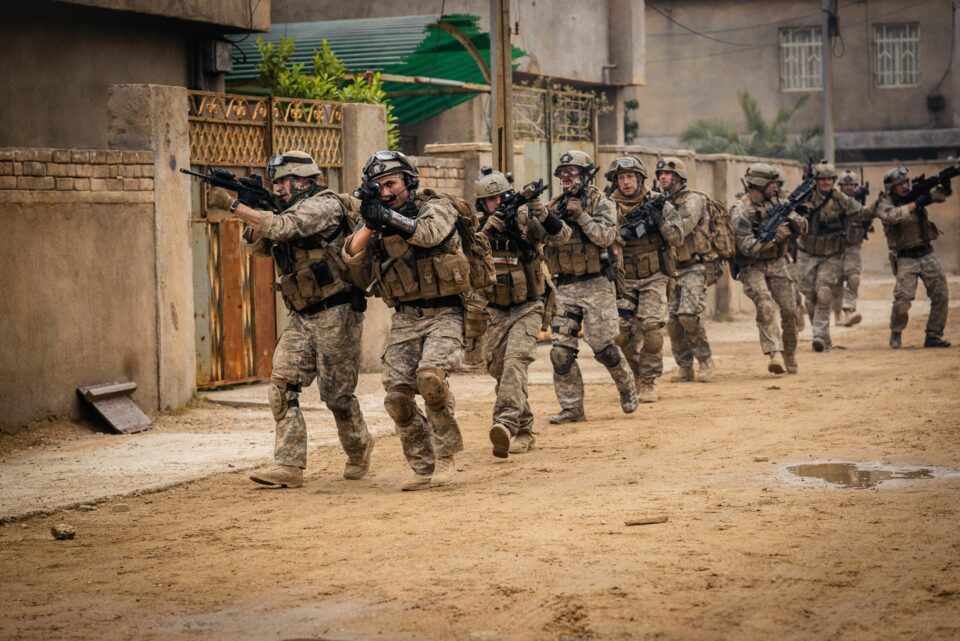




Dir: Alex Garland | Cast: Michael Gandolfini, Joseph Quinn, Kit Connor, Cosmo Jarvis, Charles Melton, Will Poulter and D’Pharaoh Woon-A-Tai | US Actioner, 95′
by Peter Herbert
Warfare travels new roads for writer director filmmaker Alex Garland and mixes the early sci fi visions of films like Devs and Men with the contemporary concerns of Civil War. The result is a war film that reimagines a real-life war incident into a new form of dystopian nightmare.
The original incident was The Battle of Ramadi on 19/11/06 during the Iraq war. A platoon of American soldiers and Navy Seals were trapped for 90 minutes in a civilian apartment building after an armoured vehicle was detonated. As they wait for the arrival of a second escape vehicle, bullets and explosions rip through rooms bringing constant fear of death.
A close bonding of men is at the heart of the film and is taken from soldiers’ first-hand testimonials. All of the film is based on memories provided by former soldier and co-director Ray Mendoza with nothing invented or altered, to recreate as close as possible the original experience of a near disastrous wartime mission.
A besieged town in Iraq recreated on an airfield in Buckinghamshire may not work for every filmmaker. For Garland and Mendoza, the artificiality of this setting channels the film’s focus into the mindset of men in war. There is no context to the nature of the conflict or background to the soldiers, and enemies are only seen at a distance or through telescopes. Garland continues, what are for some, contentious apolitical viewpoints although these are consistent with moral decisions of the earlier films.
The look of the film (cameraman David J. Thompson) is enhanced by using a palette of colours which are mainly muted browns, greys and blacks. Scenes at night use infrared ray optical screens to monitor movement which will contrast with daylight rays of sunlight illuminating red curtains in an apartment block. The blood red light of this fabric will soon give way to blood from mutilated, damaged, wounded bodies. Just as Civil War found beauty in rural decay, Garland is not unaware of signs and meanings in objects of which there are a number linked to striking images of damaged urban debris.
The cast of young actors includes D’Pharaoh Woon-A-Ta, Will Poulter, Kit Connor and Cosmo Jarvis in an ensemble of otherwise unknown faces adding to a sense of unease and the unknown. The role of women in a world of men is a thematic concern for Garland. The only mages of women in Warfare are gyrating bodies in the opening fitness DVD sequence which soldiers respond to as a form of male bonding. They are also vague figures in predominantly male Iraqi apartment and street scenes. Women can act as thought-provoking context to the behaviour of men in Civil War or as an almost surreal presence, felt though largely unseen in Warfare.
Thematically, the film may well be preceded by Ridley Scott’s Black Hawk Down 2001 which also focused on a brutal disastrous real-life incident during the 1993 war in Somalia although was made in Morocco providing a setting closer to the original incident.
Warfare may also evoke the concentrated settings of time and place in earlier war films (Robert Aldrich’s Attack, Lewis Milestone’s A Walk in the Sun, Cornel Wilde’s Beach Red and Anthony Mann’s Men in War) but sits more closely alongside Stanley Kubrick’s Full Metal Jacket 1987. This was filmed during the demolition of dockland buildings in London’s Isle of Dogs and recreated a Vietnamese city decimated at the height of the Tet Offensive. Both films use recreated locations as a form of theatre to evoke a sense of war by getting closer to the truthfulness of imagined memories of warfare.
The soundtrack is Garland’s most ambitious and strongest so far. Apart from the opening fitness disco music and closing credits there is no traditional music. Amplified by Imax stereophonic sound, the film’s soundscape (mixed by Howard Bargoff) mostly happens off screen, fusing together noise and gun fire with the explosions of bombs ripping through streets and rooms. Other discordant ricochets are balanced alongside the sounds of silence, especially effective during times of tedium in confined claustrophobic spaces. This gradually builds up an element of sensory overload with sounds of gunfire becoming a form of musical battle hymn. Images of uprooted street lampposts, resembling religious signs of the cross, reveal a visually and thematically inventive British filmmaker. @Peter Herbert
WARFARE screening at BFI IMAX 14/4/25 with introduction from Alex Garland, Kit Conner and Cosmo Jarvis | In cinemas nationwide